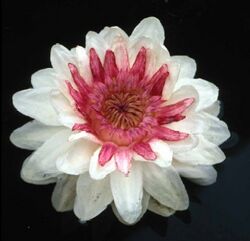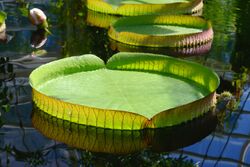Biology:Victoria cruziana
| Victoria cruziana | |
|---|---|

| |
| Flower of Victoria cruziana | |

| |
| Leaf of a Santa Cruz water lily (Victoria cruziana). Botanical Garden of Helsinki, Finland. | |
| Scientific classification | |
| Kingdom: | Plantae |
| Clade: | Tracheophytes |
| Clade: | Angiosperms |
| Order: | Nymphaeales |
| Family: | Nymphaeaceae |
| Genus: | Victoria |
| Species: | V. cruziana
|
| Binomial name | |
| Victoria cruziana A.D.Orb.
| |
Victoria cruziana (Santa Cruz water lily, water platter, yrupe, synonym Victoria argentina Burmeist.) is a tropical species of flowering plant, of the Nymphaeaceae family of water lilies native to South America, primarily Brazil, Bolivia, Argentina and Paraguay.
Description
The plant is a popular water garden plant in botanical gardens where its very large leaves can reach their fullest, up to 2 m wide with a thick rim up to 20 cm high,[1][2] although rims up to nine inches (23 centimeters) have been recorded.[3] It can be grown in cooler waters than its sisters within the genus, the more familiar giant waterlily, Victoria amazonica and the recently discovered Victoria boliviana .[4] A 25 cm diameter flower blooms for two days, arising from the underwater bud, as a white flower that turns to a deep pink on the second and final day of its bloom. V. cruziana is a thermogenetic or heat-producing plant. The plant prefers to live in colder non moving water and requires warm temperatures in order for the flower to blossom, hence the plant must distribute a lot of energy to keep itself warmer than its natural environment (above 90 degrees Fahrenheit).[5] The floral stigma are attached to a cup that is protected by spines, and the floral cup begins heating up in the bud, then, as the flower opens, it releases a strong sweet scent to attract pollinating beetles, then continues to provide heat to the flower while the beetles are pollinating.[4][6]
The diploid chromosome count of Victoria cruziana is 2n = 24.[7]
Taxonomy
Victoria cruziana was discovered in Bolivia on one of many expeditions through the country by Alcide d'Orbigny whose presence was sponsored by Andrés de Santa Cruz. The first collected specimens were returned to France where they were named in honor of Santa Cruz by Alcide's brother, Charles Henry Dessalines d'Orbigny.[citation needed]
It was first described in 1840 by Alcide d'Orbigny in Annales des Sciences Naturelles; Botanique, Ser. 2, 13, p. 57.[8] Synonyms for Victoria cruziana A.D.Orb. are: Victoria argentina Burmeist. noun nud., Victoria cruziana var. malmei F.Henkel et al., Victoria cruziana f. matogrossensis Malme, Victoria cruziana f. trickeri F.Henkel ex Malme, Victoria cruziana var. trickeri F.Henkel et al., Victoria regia var (A.D.Orb.) C.Lawson, Victoria trickeri (F.Henkel ex Malme) hort. ex Mutzek.
References
- ↑ "Victoria cruziana (Santa Cruz waterlily)". Royal Botanic Gardens. http://powo.science.kew.org/taxon/urn:lsid:ipni.org:names:605778-1.
- ↑ Nash, Helen; Steve Stroupe (2003). Complete guide to water garden plants. New York: Sterling Publishing. pp. 70–71. ISBN 1402709544.
- ↑ VanAvondt, Francois (n.d.). "Mammoth Victoria crusiana". http://www.watergardenersinternational.org/journal/2-1/francois/page1.html.
- ↑ 4.0 4.1 Lamprecht, I; E. Schmolz; S. Hilsberg; S. Schlegel (2002). "A tropical water lily with strong thermogenic behaviour— thermometric and thermographic investigations on Victoria cruziana". Thermochimica Acta 382 (1–2): 199–210. doi:10.1016/s0040-6031(01)00734-1.
- ↑ Lamprecht, I., et al. “A Tropical Water Lily with Strong Thermogenic Behaviour—Thermometric and Thermographic Investigations on Victoria Cruziana.” Thermochimica Acta, vol. 382, no. 1-2, 2002, pp. 199–210., doi:10.1016/s0040-6031(01)00734-1. “Victoria Cruziana Orb.: Plants of the World Online: Kew Science.” Plants of the World Online, powo.science.kew.org/taxon/urn:lsid:ipni.org:names:605778-1. Wu, Q., et al. “Relationship between the Flavonoid Composition and Flower Colour Variation in Victoria.” Plant Biology, vol. 20, no. 4, 2018, pp. 674–681., doi:10.1111/plb.12835.
- ↑ Lamprecht, I; E. Schmolz; L. Blanco; C.M. Romero (2002). "Flower ovens: thermal investigations on heat producting plants". Thermochimica Acta 391 (1–2): 107–118. doi:10.1016/s0040-6031(02)00168-5.
- ↑ Pellicer, J., Kelly, L. J., Magdalena, C., & Leitch, I. J. (2013). "Insights into the dynamics of genome size and chromosome evolution in the early diverging angiosperm lineage Nymphaeales (water lilies)." Genome, 56(8), 437-449.
- ↑ "Tropicos". https://www.tropicos.org/Name/22600197.
External links
Wikidata ☰ Q3030683 entry
 |

